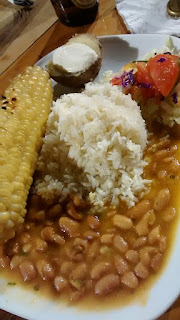The flight was uneventful, touching down briefly in Guayaquil to exchange the early-morning commuters for more holidaymakers to the isolated islands, situated 1000km off the coast of Ecuador. We landed at one of the two airports on the archipelago, on San Cristóbal, or Chatham island, as it was originally known.
San Cristóbal is the first of four islands we will be visiting this week and is moderately populated. It is a shock to see such infrastructure and buildings on what we imagine to be uninhabited islands. To be fair, the majority of the Galapagos is national park and, as such, is protected from development. Despite knowing that the wildlife has domain over the rest of the island, it was still odd to check in to the fancy Blue Marlin hotel.
First order after dropping our bags was to gather everyone for lunch. At a small, open restaurant on the corner, we had a simple soup and vegetable omelette with rice and salad. Everyone else lunched on fish, caught directly on the island. Much of the rest of the food is imported from the mainland as the small amount of land permitted to be farmed barely supports the resident community, let alone the requirements of voracious visitors.
A walk along the sea front gave us the first glimpse of the endemic and fiercely protected wildlife: sea turtles popping their heads briefly above water, red crabs contrasting against the black volcanic rocks, which they shared with sea lions, and the occasional jellyfish.
 |
| Marine iguana |
 |
| Sea lion and crabs |
At the "Interpretation Centre" farther along the coast, our guide, Mauricio, set out the route for the next week: San Cristóbal to Floreana island, thence to Isabela, arriving at Santa Cruz for our return flight to Quito.
 |
| Mauricio |
The nineteen islands that make up the Galapagos archipelago are volcanic land masses, having erupted into existence in the Pacific Ocean so far from the mainland that all of the original flora and fauna made its own way by land or sea, while later introductions to the ecosystem were brought - intentionally or otherwise - by the arrival of Man on the vicinity. Having introduced livestock and plants that unbalanced the existing ecosystem and also rapidly depleting the natural resources - e.g. killing the giant tortoises* for their fat and meat - the most recent custodians of the islands have found themselves with the tricky problem of eradicating 'pests' and invasive species.
* Darwin himself rode and ate the creatures despite being in awe of their antediluvian appearance.
Far from being a peaceful haven of species left to evolve without the effects of natural predators, the Galapagos have a chequered recent past. Having been declared in 1832 by Colonel Ignacio Hernandez as territory of the Republic of Ecuador, it wasn't long before the world reacted to this appropriation of what appeared to be common land. The US wanted to declare the islands as res nullis, but later perhaps revealed their true motives as they stationed a base on Galapagos after the attacks on Pearl Harbour. As many remote locations, the islands have also been used as prison camps over the years and other characters have taken themselves into self-imposed isolation on misanthropic grounds or attracted by the opportunity to create a utopian idyll.
With the history lesson over for now, we enjoyed the island for what it is currently - a colourful and largely natural environment teeming with unusually approachable wildlife. While pelicans rested the weight of their enormous bills on rocks nearby and the sharp-angled silhouettes of frigate birds could be seen wheeling overhead, we braved the cold water to snorkel with the marine life. At this time of year, the Humboldt current cools the sea to around 20°C - chilly enough to require a wetsuit for prolonged snorkelling - while later the Panama current will bring warmer water and, with it, jellyfish. I was happy to suffer the chill and swim among sea lions, marine turtles, and colourful fish, which reminded us of earlier stages of this trip in SE Asia.
 |
| Snorkelling with a view of Kicker Rock |
Swimming makes one hungry and so, once we had had our fill of the visual feast, we repaired to a restaurant recommended by Mauricio for dinner. Unsurprisingly, the island cuisine relies heavily on seafood and the menu offered no explicitly vegetarian choices. However, the staff were happy to cobble together a typically heavy Ecuadorian plate of choclo 'on the cob', rice, beans.
 |
| Rice and beans |
The nighttime version of the harbour front saw sea lions, having heaved themselves ashore, lying about the place like drunken men passed out on the road. The unfortunate likeness was lent an air of verisimilitude by the wet patches that extended from underneath their prone forms. Some of the figures were even slumped on the benches - how they manoeuvred themselves up remained a mystery - missing only a brown paper bag to complete the image.
 |
| One too many Tennent's |
No comments:
Post a Comment